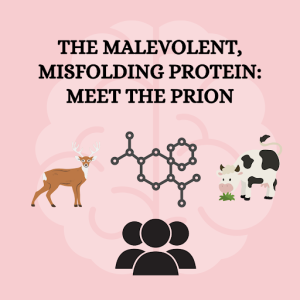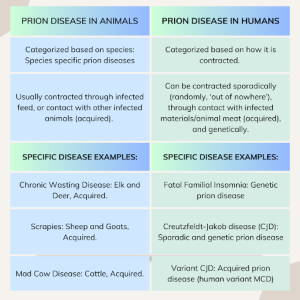The Malevolent, Misfolding Protein: Meet the Prion
By Zyara Morton, C2ST Intern, University of Illinois Urbana-Champaign
In 1980’s Britain, farmers across the country were reporting abnormal, concerning behaviors in their cattle. The cattle in question were exhibiting mood swings, lack of coordination, posture abnormalities, and sensory disturbances; such as sudden twitching. It was not long until this mysterious behavior was tied to a disease known as Bovine Spongiform Encephalopathy, more commonly known as, “Mad Cow” disease. The disease ravaged farms of cattle, and in 1996, the first human version of the disease, variant Creutzfeldt-Jakob Disease (cCJD) turned out to be fatal. This tragedy plunged the public into a spiral. What diseases can be spread from humans to animals? How can we protect against this? The following blog will dive into the culprit behind Mad Cow disease, and its perplexing nature, even in modern day — prions.

All mammals, including humans possess a sort of protein known as a prion. These proteins serve as membrane receptors for multiple molecules throughout the brain; meaning that they aid in the communication between cells on the outside and inside of the membrane. However, these normal proteins can turn malevolent—misfolding, and causing a ripple effect of other proteins to do the same. This misfolding then causes the protein chains to clump in the brain – resulting in signal interference, and proteins being sent to the wrong parts of cells. This results in prion diseases, brain damage, and deficits in motor coordination, sleep, memory, and mental wellness. Unfortunately, once an individual or animal exhibits symptoms of misfolded prions they have less than three years before passing away. This is due to the excessive amount of brain damage they cause, and the lack of a known cure—both incredibly grim factors.
Now that we have established the basis of prion disease, we can move into more specifics. The chart below details some specific prion diseases, as well as how they arise, and how this varies in humans and animals.

[To learn more about the specifics, visit this link!]
For all of the above mentioned diseases, symptoms are similar: neurological deficits causing involuntary movements, confusion, mood disruptions, adversity to physical stimuli, and more. As mentioned in the chart, prion diseases can be sporadic, genetic, and acquired. However, all known animal diseases can be acquired, so for the purpose of this blog, we will focus on this mode of infection. Like the name suggests, an acquired prion disease is when the disease is ‘acquired’ from consuming infected feed (for animals), or the infected meat of an animal—an example being vCJD (for humans). While this can be rightfully worrisome for many individuals, it seems unlikely, aside from vCJD, that other prion diseases such as Chronic Wasting Disease (CWD) can be spread to humans. In a recent study, small spheres of human brain cells were exposed to large concentrations of CWD prions for seven days. These cells were then observed for the next six months, and the results were astonishing: none of the healthy brain cells were contaminated. So, while it is still important to be cautious, and concerned about contracting Mad Cow Disease, there is relief that its devious counterpart, Chronic Wasting Disease, is unlikely to develop a human variant.
While preventing prion disease such as vCJD in humans can be mitigated by safer food management systems—there is no current solid form of treatment for the disease once symptoms set in. This could quickly be changing, as biomedical researchers at the Broad and Whiteman labs have possibly created a new form of therapy to treat prion diseases! Led by Dr. Sonia Vallabh, and Dr. Jonathan Weissman, this new treatment, known as CHARM, was found to eliminate around 80 percent of the prion protein in the brains of mice in a single intravenous injection; an incredibly significant finding. While this new treatment is still in the testing stages, it could be the key to preventing the rapid spread of prion diseases in humans, no matter how it was contracted. This would be a massive win for public health, and all of those personally affected. To learn more about Dr. Sonia Vallabh and her work, watch her TEDTALK here!
Resources
- How the Mad Cow Disease Crisis Shook Britain
- The Biological Function of the Prion Protein: A Cell Surface Scaffolding of Signaling Molecules
- Researchers Discover How Prion Protein Damages Brain Cells
- Prion Disease
- About Prion Disease
- Chronic wasting disease unlikely to move from animals to people
- A therapy candidate for fatal prion diseases turns off disease-causing gene
- My Quest to Cure Prion Disease — Before It’s Too Late